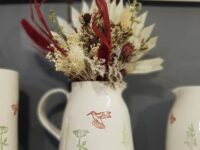
Stéphanie
Stéphanie has always loved music, dance and the arts in general. She remembers trying to imitate the birdsong in her garden at the music academy at the age of six - imitating nature through art. After a few career changes, she decided to reconnect to nature and share its richness through the environmentally friendly art of ecoprint.
Photo credit to Floriane Celle
Her dedication to high quality and respect for her art is illustrated through her active membership with the Ateliers d'Art de France.

“I put a lot of love into these textiles. I have to fight against my urge for perfection, which is impossible with ecoprint. It's a traditional craft, made up of research, a lot of patience and so much delight!”
Stéphanie (L'amour te va si bien)

Made with love from local and natural materials
Ecoprint
Exquisite wall hangings, table runners, clothes and neckerchiefs
Stéphanie chooses fabrics made from natural fibres, dyes them from plants or food residues and then prints them with the imprint of local flowers and plants.
Although the prints and fabrics seem delicate, the ecoprint process ensures a robust print which can withstand washing and ironing.
Photo credit to Maxime Gruss

Make your own ecoprint!
Workshops
Connect to your creative side and nature at the same time.
Treat yourself or a loved one to an ecoprinting course with Stéphanie to create your very own, unique print.
A great anniversary or birthday present, or even a creative activity for the family or a hen party - ecoprints are light for travelling and provide one of a kind souvenirs.

Handmade, eco-friendly and natural
The Ecoprint processes
Ecoprinting involves several crucial stages, spread over several days
Firstly, Stéphanie strips and scours the fabric to remove the primers applied to the fabrics. This is followed by a series of baths before the printing itself.
The first is mordanting, which prepares the fibre to pick up the colour and/or the tannins in the plants. Depending on the concentration of the mordanting recipe, the leaves in contact with the fabric will react differently (light, dark, background, no background).
Next, a mordant fixing bath ensures that the colour resists over time. Once these stages have been completed, it's time to get creative! The choice of leaves and flowers, as well as the composition on the fabric.
The plants are placed on the fabric to be printed and rolled tightly around the support (either a wooden stick or a rubber hose). Then they are either steamed or immersed in water, for between 20 minutes and an hour, depending on the plants and the fibre used. The last step is to gently wash the printed fabric with the famous Marseille soap, air dry and then gently iron.
See Stéphanie complete the final stages of her process here (video in French).

















